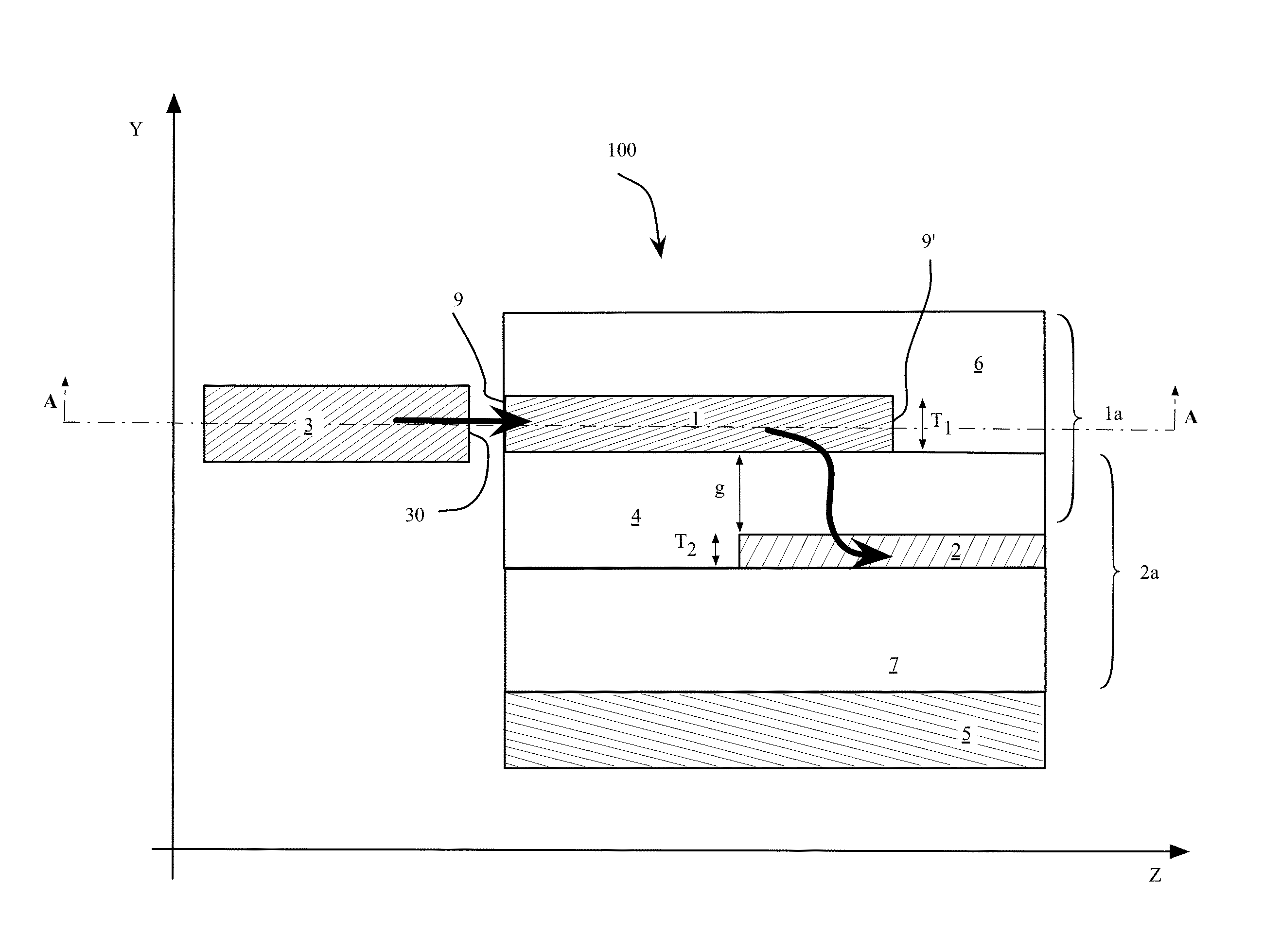Optical mode transformer, in particular for coupling an optical fiber and a high-index contrast waveguide
a transformer and optical fiber technology, applied in the field of optical mode transformers, can solve the problems of high coupling loss and high power loss of coupling, and achieve the effect of avoiding losses
- Summary
- Abstract
- Description
- Claims
- Application Information
AI Technical Summary
Benefits of technology
Problems solved by technology
Method used
Image
Examples
example 1
[0133]A SiO2:Ge first waveguide core, with nfirst core=1.483 and Δn1=2.5% having a square cross section of 2.6 μm×2.6 μm as guiding dimensions outside the coupling region is vertically arranged on top of a 150 nm thick Si waveguide (nsecond core=3.4756, Δn2=40%), the two being separated by a 1.2 μm an oxide layer (TEOS) having ncladding=1.446 at 1550 nm. First and second core are vertically aligned, i.e., no lateral misalignments exist between the first and the second waveguide. The thicknesses of both cores 1,2 remain substantially unchanged along the transformer 100 and therefore they are not further mentioned.
[0134]In this Example, the dimensions of the cores at the first cross section of FIG. 7a are W2IN=100 nm=the width of the taper tip realized in the Si waveguide, and W1IN=the thickness of the first core=2.6 μm. The first section of the overlapping region has a length L1 equal to 500 μm. At the second cross section of FIG. 7b, the second core 2 has an intermediate width W2MID...
example 2
[0138]A transformer identical to the transformer of Example 1, with the exception of the first core dimensions, has been realized by the Applicants.
[0139]In detail, referring back to FIGS. 7a and 7b, the dimensions of the cores of the transformer in this Example 2 are the following. The guiding portion of the first waveguide core 1 has a constant cross section of 3.6 μm×1.5 μm, leading therefore to an input width at the cross section represented in FIG. 7a of W1IN=3.6 μm for the first waveguide, while the width of the second waveguide core is, as in Example 1, W2IN=100 nm. The gap g between the two cores is still of 1.2 μm. At the end of the first section, having L1 equal to 500 μm, i.e., at the position depicted in the second cross section of FIG. 7b, the second core 2 has an intermediate width W2MIDDLE=200 nm, and the first core 1 is at its smallest width W1MIDDLE=1.2 m, which remains constant till the end of the overlapping region. At the output, i.e., at the end of the second se...
example 3
[0143]The same structure of Example 1 has been realized (same materials and waveguide dimensions), however first and second waveguide have 1 μm lateral misalignment. This embodiment is shown in the cross section FIG. 12, where the geometrical axes of the first and second waveguide core are schematically identified with a dot. The transformer according to this Example is globally indicated with 100′. A 1 μm lateral misalignment stands for a distance along the X direction between the two waveguides core axes of d=1 μm.
[0144]According to the performed numerical simulations, Applicants have observed that polarization mixing takes place to a minor extent in the transformer 100′ realized according to Example 3. The observed polarization coupling is limited to the amount of 20% and it is reversible, i.e., after a given propagating distance within the first waveguide, the polarization state of the travelling mode “returns” to the input polarization. At the output of the taper of the second ...
PUM
 Login to View More
Login to View More Abstract
Description
Claims
Application Information
 Login to View More
Login to View More - R&D
- Intellectual Property
- Life Sciences
- Materials
- Tech Scout
- Unparalleled Data Quality
- Higher Quality Content
- 60% Fewer Hallucinations
Browse by: Latest US Patents, China's latest patents, Technical Efficacy Thesaurus, Application Domain, Technology Topic, Popular Technical Reports.
© 2025 PatSnap. All rights reserved.Legal|Privacy policy|Modern Slavery Act Transparency Statement|Sitemap|About US| Contact US: help@patsnap.com



